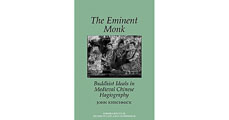start > Klassieke teksten > Late Han tot Tang > tekst
續高僧傳 Xu gaosengzhuan
Engelse titel: Continued biographies of eminent monks
also known as Tang gaosengzhuan 唐高僧傳
The Xu Gaoseng zhuan, by Shi Daoxuan 釋道宣(597-667), is modeled on Huijiao's Gaoseng zhuan, q.v., and picks up where that text left off, providing biographies of monks from the sixth century to the seventh. Like the Gaoseng zhuan, it was compiled privately, based on stele inscriptions, court documents, miracle tale collections, prefaces to scriptures, oral accounts, and, to a limited extent, personal observation. Although more independent accounts of monks are available for the period Daoxuan covers than for the period Huijiao covered in his work, the Xu Gaoseng zhuan remains the standard source for biographical information about monks for the late sixth and early seventh centuries. Unlike the Gaoseng zhuan, which is relatively weak in its coverage of the north, the Xu Gaoseng zhuan provides extensive information on monks from all parts of China. Although much of the work is concerned with monks who lived during the Tang era, it is an important source for the Six Dynasties as well, providing information on doctrinal
developments, monasticism, state policy toward Buddhism, popular religion, and
everyday life.
The Xu Gaoseng zhuan contains 485 major biographies with 219 subordinate biographies. Coverage extends from the first year of the Liang Dynasty (501) to the year 665. The biographies are divided into ten categories (zie tab hoofdstukken).
Daoxuan was one of the most versatile and prolific monks of his generation. The son of a prominent official, he lived for most of his life in the Tang capital at Chang'an, where he worked briefly at Xuanzang's translation center and later served as abbot of the Ximing Monastery (Ximing si 西明寺).His works include a catalog of Buddhist writings, various historical texts, numerous writings on the monastic regulations, and records of his visionary encounters with divine beings. His writings had an impact on all of these genres, but especially on historiography and the study of the monastic regulations. (John Kieschnick in Chennault 2014 Early medieval Texts, p428-429)
Er zijn vier boeken ‘Biografieën van excellente monniken’, geschreven in vier verschillende dynastieke perioden: (Liang) Gaoseng zhuan, Xu gaoseng zhuan (ook Tang gaoseng zhuan), Song gaosengzhuan en (Da-) Ming gaosengzhuan.
Indeling tekst
Onderstaande indeling van John Kieschnick
01. 譯經 Yijing - Translators
02. 義解 Yijie - Exegetes
03. 習禪 Xichan - Practitioners of meditation
04. 明律 Minglü - Elucidators of the regulations (scholars of the Vinaya)
05. 護法 Hufa - Defenders of the Dharma (monks who defended Bud dhism at court)
06. 感通 Gantong - Resonance (devoted to miracle workers)
07. 遺身 Yishen - Those who sacrificed themselves (monks who sacrificed their bodies in acts of charity or devotion)
08. 讀誦 Dusong - Chanters
09. 興福 Xingfu - Benefactors (literally, the "generation of merit," for monks who solicited funds for or otherwise contributed toward Buddhist construction and other worthy enterprises)
10. 雜科 Zake - Miscellany
These categories are slightly different from those of Huijiao. Most of the changes are adjustments in nomenclature (gantong for shenyi 神異, yishen for wangshen 亡 身 ,dusong for song jing 誦經 ) . More substantially , Daoxuan eliminated the category of hymnodists (jingshi 經師) and introduced a chapter devoted to monks who "defended the Dharma." Following Huijiao, at the end of each section Daoxuan appended a "disquisition" (lun 論) in which he discusses the theme of the section.
Literatuur en vertalingen
Hieronder kunt u een selectie maken van de verschillende publicatievormen en de taal. Ik beperk me tot vier taalgebieden (Nederlands, Engels, Frans en Duits). De meeste literatuur is overigens engelstalig. U kunt bij teksttype ook apart de vertalingen selecteren en U kunt desgewenst ook een specifieke auteur zoeken.
Boeken 1 tot 2 van de 2

Greene, Eric (2008). Another Look at Early Chan: Daoxuan, Bodhidharma, and the Three Levels Movement. T'Oung Pao, Vol. 94, pag. 49-114. *.
Kieschnick, John (1997). The Eminent Monk: Buddhist Ideals in Medieval Chinese Hagiography. University of Hawaii Press. *
Ook online.
Boeken 1 tot 2 van de 2

